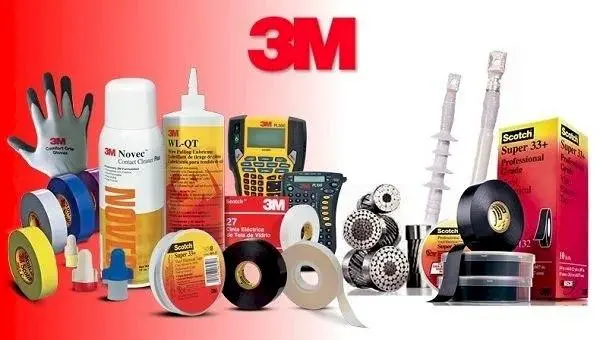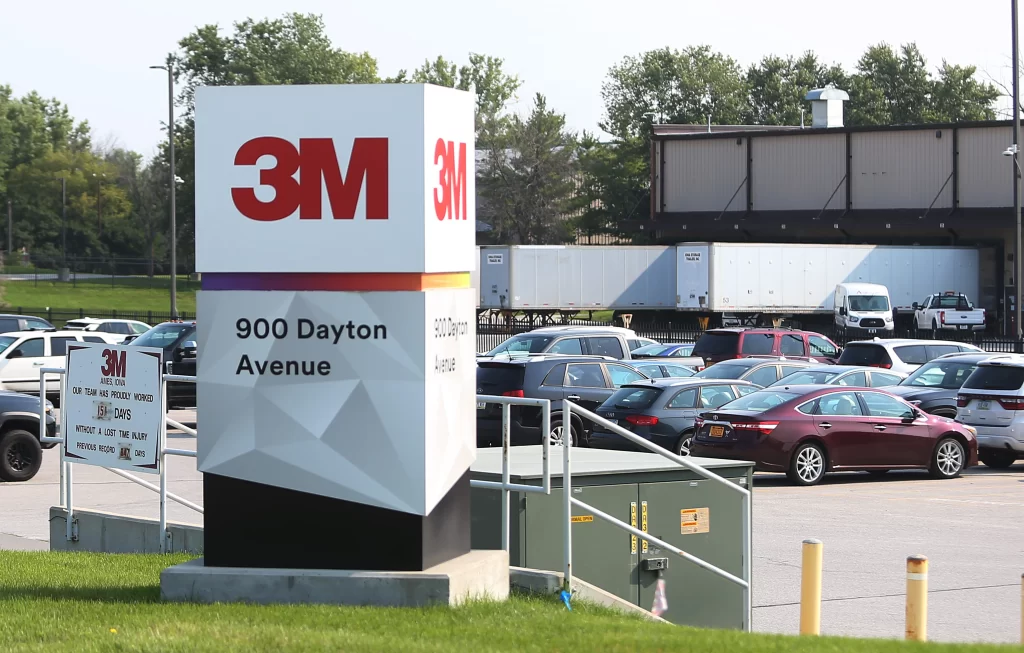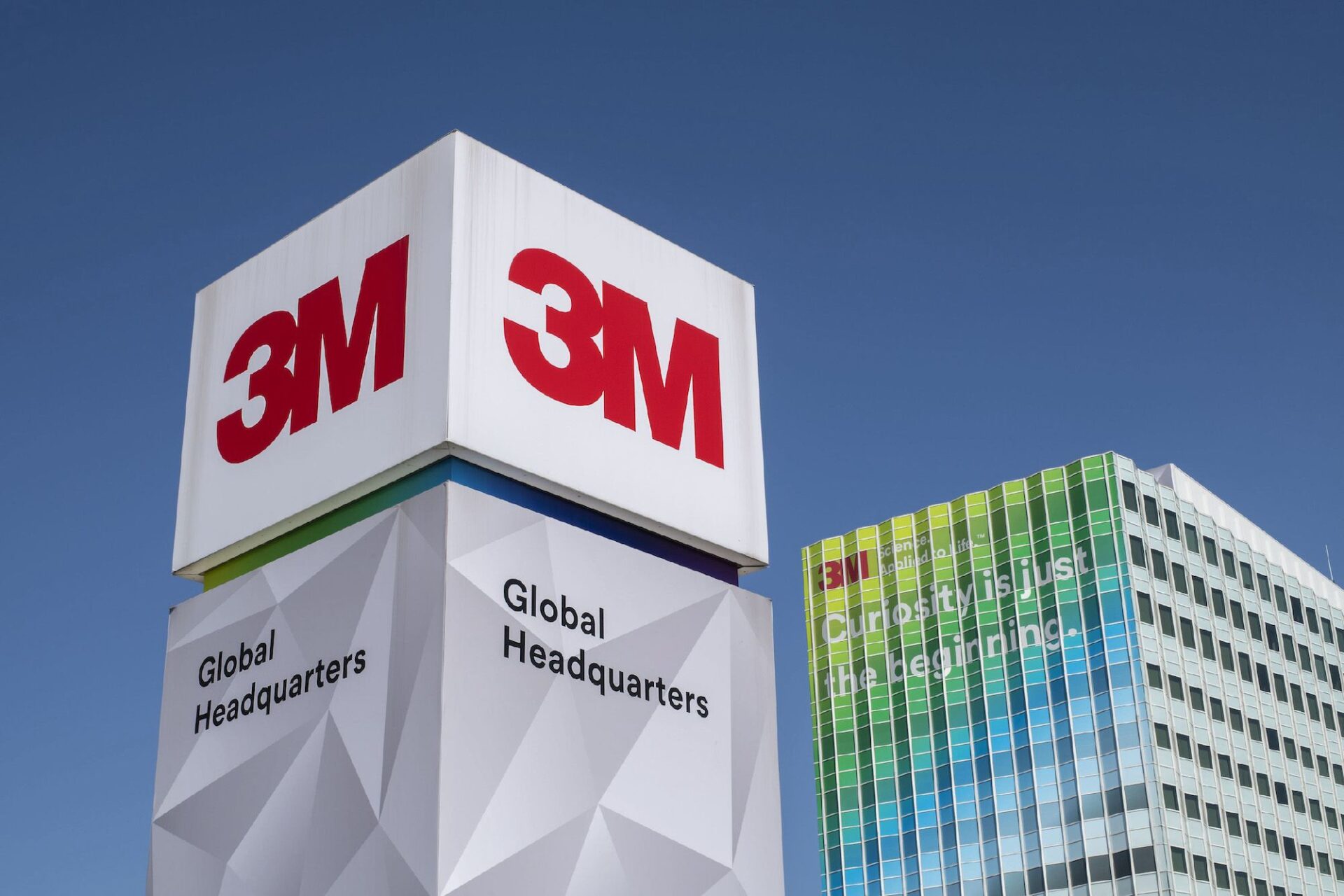3M Company, originally known as the Minnesota Mining and Manufacturing Company, is a prominent American multinational conglomerate. It operates across various industries, including industry solutions, worker safety, healthcare, and consumer goods. The company boasts an extensive product portfolio, comprising over 60,000 items spanning multiple brands.
3M manufactures an array of products, such as adhesives, abrasives, laminates, passive fire protection materials, personal protective equipment, window and paint protection films, dental and orthodontic supplies, electrical and electronic insulating materials, medical equipment, car-care products, electronic circuits, healthcare software, and optical films. Its headquarters is located in Maplewood, a suburb of Saint Paul, Minnesota.

In terms of financial performance, 3M reported total sales of $33.04 billion in the year 2023, earning it the 102nd spot in the prestigious Fortune 500 list of the largest corporations in the United States by total revenue. As of 2023, the company boasted a global workforce of around 95,000 employees and maintained operations in more than 70 countries. Additionally, 3M has established international subsidiaries, including 3M India, 3M Japan, and 3M Canada.
Marketing Strategies of 3M
3M, a diversified American multinational corporation, implements a multifaceted marketing strategy to promote its wide range of products and solutions across various industries. Here is a detailed explanation of 3M’s key marketing strategies:
1. Product Diversification
Product diversification has been a critical component of 3M’s marketing strategy over the years. By expanding its portfolio beyond traditional adhesives and abrasives, 3M has positioned itself as a multifaceted innovator across various industries and applications. Here are some examples of how 3M has pursued product diversification as a marketing strategy:
Healthcare Solutions: In recent years, 3M has developed a range of medical technologies and supplies, including surgical masks, patient monitoring systems, and drug delivery devices. By entering this growing sector, 3M has expanded its reach and relevance within healthcare communities worldwide.
Electronic Materials: To address the evolving demands of electronics manufacturers, 3M has created advanced materials for semiconductors, displays, solar panels, and other electronic components. This expansion into emerging markets allows 3M to capitalize on burgeoning industry trends and maintain its competitive edge.
Consumer Goods: 3M produces a wide array of consumer products, ranging from Post-It Notes and Scotch tape to respirators and reflective road safety equipment. By catering to diverse end-user segments, 3M broadens its appeal and increases the likelihood of capturing additional sales from existing customers.
Safety and Security: Recognizing the importance of protecting people and assets, 3M has developed security films, window protection systems, and personal protective equipment (PPE) for industrial settings. By addressing safety concerns across multiple sectors, 3M positions itself as a trusted provider of essential solutions.
2. Market Segmentation
3M tailors its marketing efforts to target specific industry segments, such as healthcare, automotive, industrial, and consumer markets. This approach enables them to address the unique needs of each sector effectively. They offer customized solutions and product bundles to cater to the distinct requirements of different customer groups.
Geographic Segmentation: 3M adapts its products and services to local preferences and requirements around the globe. For instance, it offers region-specific automotive aftermarket products, construction materials, and personal safety gear designed for unique environmental conditions and cultural norms.
Demographic Segmentation: 3M targets particular age, gender, income, education, ethnicity, and lifestyle groups with appropriate product lines and advertising campaigns. Its home improvement products may be aimed at DIY enthusiasts or professional contractors, while its healthcare solutions could be geared towards patients, caregivers, or clinicians.
Psychographic Segmentation: 3M identifies clusters of consumers who share similar values, attitudes, interests, behaviors, or personality traits. It then develops niche brands, such as Command hooks for organized living or Nexcare bandages for fashion-conscious individuals seeking style along with functionality.
Behavioral Segmentation: 3M categorizes buyers according to their usage patterns, benefits sought, occasions, user status, or level of involvement with its products. For example, it might create specialized cleaning solutions for commercial establishments versus residential households or differentiate between heavy industrial users and occasional hobbyists.
Business/Industry Segmentation: 3M caters to specific business verticals, such as transportation, energy, oil & gas, mining, food & beverage processing, or telecommunications, with industry-tailored products and support services. This helps foster long-term partnerships and collaborations with major clients.
3. Trade Shows and Events
Trade shows and events have been an integral part of 3M’s marketing strategy for many years. Participating in these gatherings enables 3M to showcase its latest innovations, connect with current and prospective customers, build brand awareness, and stay ahead of industry trends. Here are some ways 3M leverages trade shows and events as a marketing strategy:
Showcasing New Technologies: At trade shows and exhibitions, 3M often unveils cutting-edge products and prototypes that demonstrate its commitment to research and development. This not only generates buzz among attendees but also attracts media coverage, amplifying the company’s visibility.
Networking Opportunities: Attending trade shows provides 3M with chances to interact directly with key decision-makers, influencers, and thought leaders from various industries. These face-to-face interactions help strengthen relationships, identify new business prospects, and gain valuable insights into market dynamics.
Brand Building: Through creative booth designs, interactive demonstrations, and engaging presentations, 3M creates immersive experiences that reinforce its brand identity and highlight its expertise. By consistently delivering high-quality content and memorable encounters, 3M solidifies its reputation as an innovative leader in numerous fields.

4. Customer Education
Educating customers is an essential aspect of 3M’s marketing strategy, particularly given the technical nature of many of its products. Providing educational content helps build trust, fosters long-term relationships, and positions 3M as a thought leader in various industries. Here are some specific ways 3M leverages customer education as part of its marketing plan:
Technical Resources and Guides: 3M creates comprehensive guides, tutorials, videos, webinars, white papers, and case studies to help customers fully utilize its products. These resources cover topics such as installation instructions, troubleshooting tips, best practices, industry trends, and application examples.
Educational Events and Workshops: 3M organizes seminars, conferences, exhibitions, and hands-on workshops at various locations around the globe. These events bring together experts, users, and potential clients to discuss relevant issues, share experiences, and learn about new technologies, techniques, and product advancements.
Online Communities and Forums: 3M maintains active online communities and discussion boards where customers can interact with peers, ask questions, seek advice, and collaborate on projects. Moderated by 3M representatives and subject matter experts, these platforms create engagement, encourage user-generated content, and reinforce brand loyalty.
Personalized Outreach and Training: 3M provides personalized consultations, training sessions, and demonstrations tailored to individual client needs. Through one-to-one interactions, 3M helps customers optimize their use of products, address specific pain points, and discover new applications.
Content Marketing and Thought Leadership: 3M produces informative blog posts, articles, infographics, podcasts, and newsletters covering current industry trends, emerging technologies, and best practices. By positioning itself as a thought leader, 3M attracts potential customers seeking authoritative insights and valuable information, enhancing its reputation and building lasting relationships.
5. Strong Distribution Network
trong distribution network is one of the key marketing strategies for 3M, which has helped them expand their reach globally. 3M operates through multiple channels including direct sales, distributors, retailers, online platforms, and other partnerships. This multi-channel approach allows them to cater to different customer segments and geographies effectively. Here are some ways that strong distribution networks have contributed to 3M’s success:
Wide Reach: By leveraging multiple distribution channels, 3M can reach customers across diverse industries, markets, and regions. For example, they sell products directly to consumers through e-commerce platforms like Amazon, while also partnering with large retail chains such as Walmart and Target. They also work closely with industrial distributors who serve businesses in specific sectors like automotive, construction, and manufacturing.
Customer Convenience: With a robust distribution network, 3M ensures that customers can access their products easily and conveniently. Whether customers prefer shopping online or visiting physical stores, 3M makes it possible for them to purchase their products without any hassle.
Cost Savings: By working with distributors and retailers, 3M can reduce costs associated with maintaining a large sales force and managing logistics operations. Distributors handle inventory management, order fulfillment, and delivery, allowing 3M to focus more on product development and innovation.

In summary, 3M’s marketing strategies revolve around diversification, innovation, market segmentation, digital presence, sustainability, and a customer-centric approach. Their ability to cater to various industries and adapt to changing market dynamics contributes to their continued success as a global leader in innovation and product solutions.
Marketing Mix of 3M
3M, a global innovation company, effectively employs the marketing mix, also known as the 4Ps (Product, Price, Place, and Promotion), to market its wide range of innovative products and solutions. Let’s delve into the details of how 3M utilizes each element of the marketing mix:
Product
-
- Diverse Product Portfolio: 3M boasts an extensive and diversified product portfolio spanning various industries, including adhesives, abrasives, safety and personal protective equipment, healthcare solutions, consumer goods, and more.
- Innovation and R&D: A cornerstone of 3M’s product strategy is innovation. They invest heavily in research and development to create groundbreaking solutions and technologies, often leading to patents and industry-leading products.
- Customization: 3M offers customization services, tailoring solutions to meet the unique needs of different industries and customers. This flexibility enhances the appeal of their products.
Price
-
- Value-Based Pricing: 3M typically employs a value-based pricing strategy, aligning the price of their products with the perceived value they provide. Customers are often willing to pay a premium for the quality and innovation synonymous with 3M products.
- Competitive Pricing: In some markets and segments, 3M may adopt competitive pricing to gain market share. They carefully assess competitors’ pricing strategies and adjust their own accordingly.
Place (Distribution)
-
- Global Presence: 3M maintains a robust global presence with operations spanning numerous countries and regions. They establish subsidiaries, manufacturing facilities, and distribution networks worldwide to ensure widespread availability.
- Distribution Partnerships: Collaborations with distributors, retailers, and industry-specific partners play a pivotal role in 3M’s distribution strategy. They adapt their distribution channels to suit the unique requirements of various market segments.
Promotion
-
- Digital Marketing: 3M leverages digital marketing channels, including their official website, social media platforms, and online advertising, to reach and engage a broad audience. They utilize these platforms for product showcases, educational content, and customer engagement.
- Content Marketing: The company creates informative content, such as articles, videos, webinars, and case studies, to educate customers about their products and showcase their expertise across different industries.
- Participation in Trade Shows: 3M actively participates in trade shows, exhibitions, and industry events globally. This provides an opportunity to showcase their products, connect with potential clients, and stay abreast of industry trends.
- Corporate Responsibility and Sustainability: 3M places emphasis on corporate responsibility and sustainability initiatives. Their promotion includes communicating their commitment to eco-friendly practices, community engagement, and responsible business conduct.
In conclusion, 3M’s marketing mix is characterized by a diverse product portfolio, innovation-driven pricing, a global distribution network, digital promotion, and a strong commitment to sustainability, customer education, and industry-specific marketing. These strategies have contributed to 3M’s success as a global leader in innovation and technological solutions across various sectors.
STP Analysis of 3M
Segmentation
Geographic Segmentation: 3M operates in over 70 countries globally. The company recognizes that different regions have varying cultural, regulatory, and economic environments. Therefore, they adjust their products and services accordingly to cater to these differences. For example, 3M’s automotive aftermarket division offers region-specific products and services to match the specific needs of car owners in various parts of the world. This geographic segmentation allows 3M to better serve its diverse international clientele while also expanding its reach.
Demographic Segmentation: Demographics refer to characteristics such as age, gender, income, education, occupation, family size, ethnicity, religion, and nationality. 3M takes advantage of this type of segmentation by creating products and services tailored to specific demographic groups. For instance, 3M’s home improvement products are often aimed at families who want to renovate or upgrade their homes. On the other hand, 3M’s healthcare products are primarily focused on meeting the needs of aging populations seeking improved health outcomes. By understanding the unique needs of different demographic groups, 3M can create targeted offerings that resonate with its clients.
Psychographic Segmentation: This form of segmentation involves categorizing people based on shared interests, values, attitudes, and lifestyles. 3M utilizes psychographic segmentation when developing products and services that appeal to particular groups of individuals. For example, 3M’s Scotch® brand offers a variety of tapes and adhesives that cater to DIY enthusiasts looking for creative ways to express themselves through crafting and home decorating projects. Similarly, 3M’s Nexcare™ bandages come in designs that appeal to children, making medical treatments less intimidating and more fun. By identifying common psychological traits within certain groups, 3M can create products that align with their values and preferences.
Behavioral Segmentation: Behavioral segmentation focuses on how potential buyers act in relation to a product category. It considers factors such as purchase behavior, usage rate, brand loyalty, response to promotions, and degree of involvement in the buying process. 3M leverages this information to design products and services that meet the specific behaviors exhibited by different consumer groups. One way 3M does this is by offering a broad range of Post-It® Notes colors, sizes, and formats to accommodate the varied note-taking habits of its users.
Targeting
Once 3M has identified its segments via segmentation, it selects specific target markets to focus on. 3M chooses its target markets based on several criteria, including:
- Attractiveness: 3M evaluates each market segment’s potential profitability, growth prospects, and competitive landscape before deciding whether to pursue it. Factors like market size, customer demand, competition intensity, and barriers to entry influence this assessment.
- Relevance: 3M ensures that its target markets align with its core capabilities and resources. If a market requires significant changes to its business model or investments beyond its means, it may not be considered relevant.
- Accessibility: 3M must identify effective methods to access its chosen target markets. This might involve building distribution channels, establishing partnerships, or modifying its product offerings to suit local requirements.
Based on these considerations, 3M has selected the following primary target markets:
Industrial Market: 3M caters to various industries, including manufacturing, construction, oil and gas, mining, transportation, and utilities. This market represents a substantial portion of 3M’s revenue, accounting for around 35% of total sales in 2020. 3M offers a wide range of products designed to optimize production processes, enhance worker safety, and minimize environmental impact. Examples include abrasives, adhesives, ceramics, electrical products, filtration systems, fire protection, fluids, graphic arts, insulation, lighting, noise reduction, packaging, polymers, purification, roofing granules, sealing, surface modification, thermal management, and ventilation.
Consumer Market: The consumer market accounts for approximately 30% of 3M’s annual sales. In addition to serving individuals directly, 3M also reaches end-users through retail partnerships and collaborations with other brands. For example, 3M works closely with automakers to integrate its products into vehicles, such as Scotchgard™ Protector Film for paint protection or Thinsulate™ Insulation for improved cabin comfort. By partnering with major players across various industries, 3M expands its reach and increases the likelihood of consumers encountering its products.
Health Care Market: As one of the largest providers of healthcare products worldwide, 3M serves hospitals, clinics, pharmacies, and patients directly. The company offers a wide range of medical and surgical supplies, skin health and infection prevention products, drug delivery systems, health information systems, and oral care solutions. With an aging population and increasing healthcare demands globally, 3M recognizes the long-term growth potential of this market.
Safety and Graphics Market: Spanning both commercial and residential applications, this division includes traffic safety products like reflective sheeting, pavement markers, work zone devices, and intelligent transportation systems. Road marking systems, traffic management products, and transit advertising displays are geared towards municipalities, government agencies, and transportation authorities. Architectural finishes, commercial graphics, and protective films serve architects, designers, builders, and property owners. Some products can also benefit households, such as security films, decorative surfaces, and window tinting for energy efficiency and privacy.
By focusing on distinct yet interconnected markets, 3M leverages its expertise in science, technology, engineering, mathematics, and medicine (STEMM):
| Target Markets | Leveraged STEMM Disciplines | Key Product Offerings |
|---|---|---|
| Industrial Market | Science, Technology, Engineering | Abrasives, Adhesives, Ceramics, Electrical Products, Filtration Systems, Fluids, Graphic Arts, Insulation, Lighting, Noise Reduction, Packaging, Polymers, Purification, Roofing Granules, Sealing, Surface Modification, Thermal Management, Ventilation |
| Consumer Market | Technology, Design, Material Sciences | Adhesives, Air Filters, Cleansers, Construction & Home Improvement Tools, Dental & Orthodontic Products, Electronics & Display Solutions, Food Preparation & Cookware, Glass Bubbles & Particles, Home Security & Monitoring Devices, Office Supplies & Stationery, Personal Protective Equipment, Renewable Energy Solutions, Skin Health & Infection Prevention |
| Health Care Market | Medicine, Biotechnology, Life Sciences | Medical & Surgical Supplies, Skin Health & Infection Prevention Products, Drug Delivery Systems, Health Information Systems, Oral Care Solutions |
| Safety & Graphics Market | Traffic Engineering, Transportation Planning, Architecture & Design | Reflective Sheeting, Pavement Markers, Work Zone Devices, Intelligent Transportation Systems, Road Marking Systems, Traffic Management Products, Transit Advertising Displays, Architectural Finishes, Commercial Graphics, Protective Films, Window Tinting, Decorative Surfaces, Security Films |
Positioning
Now that we have discussed 3M’s target market segments and their corresponding product offerings, let’s delve deeper into the positioning aspect of STP analysis.
Positioning refers to the process of creating a unique image or identity for a brand, product, or service in the minds of customers. It involves identifying a specific niche within the marketplace where the offering can be differentiated from competitors and meet customer needs more effectively. For 3M, here are some ways they position themselves in each of their target markets:
Industrial Market: In this segment, 3M positions itself as a provider of innovative technological solutions tailored specifically for industrial settings. They emphasize their ability to improve operational efficiencies, reduce costs, enhance worker safety, and increase overall quality standards. Their diverse portfolio of products allows them to cater to different industry verticals while maintaining a strong focus on sustainability and environmental responsibility.
Consumer Market: For the consumer market, 3M adopts a multi-faceted approach by offering a broad range of products designed to simplify daily life tasks and enhance personal experiences. From adhesives and air filters to dental and orthodontic products, 3M positions itself as a trustworthy source of high-quality, reliable, and user-friendly solutions. Additionally, their commitment to sustainability and corporate social responsibility helps attract environmentally conscious consumers.
Health Care Market: In the healthcare sector, 3M positions itself as a leading provider of advanced medical technologies and solutions aimed at improving patient outcomes and enhancing healthcare professionals’ capabilities. Their extensive lineup of medical and surgical supplies, along with skin health and infection prevention products, highlights their dedication to promoting better healthcare practices and ensuring patient wellbeing.
Safety & Graphics Market: Within the safety and graphics market, 3M positions itself as a pioneer in developing cutting-edge traffic management systems, roadway infrastructure improvements, and intelligent transportation solutions. By focusing on these areas, 3M demonstrates its commitment to making roads safer and more efficient for all users. The company also offers a wide array of graphic design services, including architectural finishes, commercial graphics, and decorative surfaces, allowing it to tap into the creative aspects of this market.
Electronics & Energy Market: In the electronics and energy market, 3M positions itself as an innovator in semiconductor manufacturing, photovoltaics, and LED technologies. This focus on emerging technologies sets 3M apart from traditional players in the electronic components space and enables the company to capitalize on growing demand for renewable energy sources and energy-efficient devices.
Communications Market: For the communications market, 3M positions itself as a provider of essential tools for effective communication, such as organizational productivity software, digital signage solutions, retail solutions, library resources, and other collaborative tools. By addressing the evolving needs of businesses and organizations, 3M establishes itself as a valuable partner in facilitating seamless information exchange and streamlining workflow processes.
Overall, 3M’s positioning strategy across various markets reflects its commitment to delivering innovative solutions that solve real-world problems, enhance people’s lives, and contribute positively to society.
Also Read: The Unmatched Legacy of 3M: Innovating for a Better Future
To read more content like this, subscribe to our newsletter



